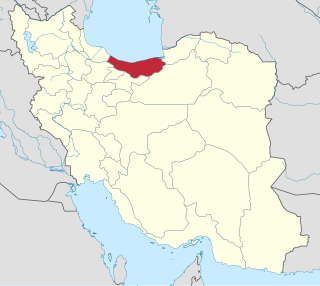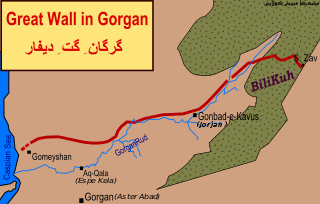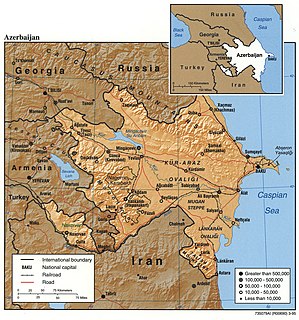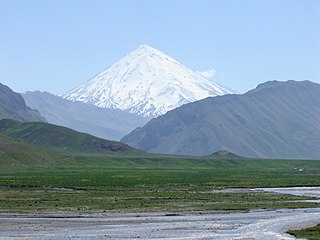
Mazandaran Province, is an Iranian province located along the southern coast of the Caspian Sea and in the adjacent Central Alborz mountain range, in central-northern Iran.

Golestān Province is one of the 31 provinces of Iran, located in the north-east of the country south of the Caspian Sea. Its capital is Gorgan.

The Great Wall of Gorgan is a Sasanian-era defense system located near modern Gorgan in the Golestān Province of northeastern Iran, at the southeastern corner of the Caspian Sea. The western, Caspian Sea, end of the wall is near the remains of the fort at: 37.13981°N 54.1788733°E; the eastern end of the wall, near the town of Pishkamar, is near the remains of the fort at: 37.5206739°N 55.5770498°E. The title coordinate is for the location of the remains of a fort midway along the wall.
Apollodorus of Artemita was a Greek historian who flourished between 130 and 87 BC. He hailed from the Greco-Parthian city of Artemita in Apolloniatis and was a citizen of the Parthian Empire.
The Hyborian Age is an essay by Robert E. Howard pertaining to the Hyborian Age, the fictional setting of his stories about Conan the Cimmerian. It was written in the 1930s but not published during Howard's lifetime. Its purpose was to maintain consistency within his fictional setting.

The Gates of Alexander was a legendary barrier supposedly built by Alexander the Great in the Caucasus to keep the uncivilized barbarians of the north from invading the land to the south. The gates were a popular subject in medieval travel literature, starting with the Alexander Romance in a version from perhaps the 7th century.

Gonbad-e Kavus is the Iranian city known historically as Gorgan/Hyrcania. The modern name, meaning "the tower of Kavus", is a reference to the most imposing ancient monument in the city. The historic name cannot now be restored, as it was oddly and carelessly assigned to the neighboring historical city of Astarabad in the 1930s by the Iranian government. At one point, it was even known as the city of Dashte Gorgan, meaning "the Plains of Gorgan".

Talysh Mountains is a mountain range in far southeastern Azerbaijan and far northwestern Iran within Ardabil Province and Gilan Province.
For the fantasy roleplaying adventure game see City of Skulls

The Lankaran Lowland is a narrow strip of lowland in southern Azerbaijan by the Caspian Sea. It is the southward extension of the Kura-Aras Lowland which in itself is an extension of the Aral–Caspian Depression. It is named after the city of Lənkəran.

The Caspian Hyrcanian Mixed Forests ecoregion, in the temperate broadleaf and mixed forests biome, is an area of lush lowland and montane forests covering about 55,000 square kilometres (21,000 sq mi) near the southern shores of the Caspian Sea of Iran and Azerbaijan. The forest is named after the ancient region of Hyrcania.

The Caspian Sea is the world's largest inland body of water, variously classed as the world's largest lake or a full-fledged sea. It is an endorheic basin located between Europe and Asia, to the east of the Caucasus Mountains and to the west of the broad steppe of Central Asia. The sea has a surface area of 371,000 km2 and a volume of 78,200 km3. It has a salinity of approximately 1.2%, about a third of the salinity of most seawater. It is bounded by Kazakhstan to the northeast, Russia to the northwest, Azerbaijan to the west, Iran to the south, and Turkmenistan to the southeast. The Caspian Sea is home to a wide range of species and may be best known for its caviar and oil industries. Pollution from the oil industry and dams on rivers draining into the Caspian Sea have had negative effects on the organisms living in the sea.

The Alborz, also spelled as Alburz, Elburz or Elborz, is a mountain range in northern Iran that stretches from the border of Azerbaijan along the western and entire southern coast of the Caspian Sea and finally runs northeast and merges into the Aladagh Mountains in the northern parts of Khorasan. This mountain range is divided into Western, Central, and Eastern Alborz Mountains. The Western Alborz Range runs south-southeastward almost along the western coast of the Caspian Sea. The Central Alborz runs from west to east along the entire southern coast of the Caspian Sea, while the Eastern Alborz runs in a northeasterly direction towards the northern parts of the Khorasan region southeast of the Caspian Sea. Mount Damavand, the highest mountain in Iran measuring 5,610.0 m, is located in the Central Alborz Mountains.

Tabarestan Higher Education Institution (TU) is an institution of higher education in Formal sciences, Physical sciences, Social sciences, Behavioral sciences and Engineering in Chaloos, Iran. The institution is located in Chaloos near Caspian Sea and Caspian Hyrcanian mixed forests and beside Nowshahr port.

Havar is a village in Almeh Rural District, Samalqan District, Maneh and Samalqan County, North Khorasan Province, Iran. At the 2006 census, its population was 228, in 56 families. Havar is noteworthy for marking the Easternmost extremity of the highly biodiverse Caspian Hyrcanian mixed forests - most of which are to be found fringing the Caspian Sea. The spur - almost 'Island' - of forest which Havar shares with the villages of Jowzak, Darkesh and Kashanak owes its extension into the more arid regions to the East of the Caspian to the trapping of moisture from that sea by the Aladagh Mountains, which form an extension, of lower altitude, of the Alborz mountains to the West. This forested area lies within the Khorasani Kurdish region of Northeastern Iran and Southwestern Turkmenistan. The only settlement of any size close to Havar and its neighbouring villages is Bojnord the capital of North Khorasan Province.
Atropa pallidiflora is a close relative of the infamous deadly nightshade and, like it, is an extremely poisonous plant, containing a variety of tropane alkaloids valued in medicine for their anticholinergic, antispasmodic and mydriatic properties and deliriant in excess. Atropa pallidiflora is the least well-known of the four currently accepted species of Atropa and is endemic to the remarkable Caspian Hyrcanian mixed forests of Northern Iran, which can boast all the species of Atropa currently recognised, with the sole exception of the strictly Ibero-Maghrebi A.baetica. The binomial Atropa pallidiflora was published by Eva Schönbeck-Temesy in volume 100 ('Solanaceae') of Karl Heinz Rechinger's monumental Flora Iranica in 1972. The specific name pallidiflora signifies 'bearing flowers of a pale, wan or washed-out hue' and, while appropriate, is not especially evocative, given that the flowers of most Atropa species are far from vivid. The flowers of A. pallidiflora, like those of A.baetica, vary from greenish to yellow, but, as the designation 'having pallid flowers' might suggest, the yellow in question is a dingy greenish-yellow that is far from ornamental. The geographical term 'Hyrcanian' in the common name signifies that the plant is native to what was once the satrapy of Hyrcania, the name of which derives from an Iranian root meaning 'wolf' : Hyrcania is thus the 'Land of Wolves'. The name is an apt one, since the Hyrcanian forests have long been known as a hunting ground of legendary richness and beauty : the lush forests could support an abundance of large, mammalian herbivores, which in turn could support an abundance of apex predators - notably the wolf, but also the Persian leopard and even the tiger. The word 'Hyrcanian' will be familiar to any diligent reader of the works of William Shakespeare, as an epithet of the proverbially savage Caspian Tiger, known to the dramatist from his reading of the works of various Latin authors - who, in turn, were familiar with the Ancient Greek coinage 'Hyrcania' and the lands adjoining the Caspian Sea to which the place name referred. Regarding the richness of the Hyrcanian flora - of which Atropa pallidiflora is a noteworthy element - it is worth mentioning that the name of the modern Iranian province of Golestan has the delightful meanings of 'Rose Garden' and 'Land of Flowers'.

Hyrcanis or Hyrkaneis, also known as Hyrcania, was a Roman and Byzantine-era city and bishopric in ancient Lydia, now in western Turkey. It was situated in the Hyrcanian plain, which is said to have derived its name from a colony of Hyrcanians being settled here by the Persians. They were afterwards mingled with some Macedonians, who also settled in this district, whence they are called by Pliny the Elder and Tacitus "Macedones Hyrcani." The city minted its own coins.

The Hyrcani were a people group in the classical era. They were mentioned in both the southern coastline of the Caspian Sea and the Hermos River valley, in Lydia, (Turkey).















